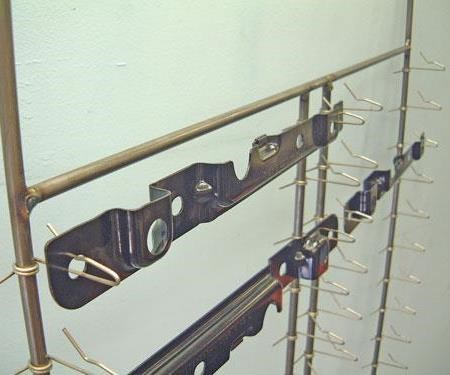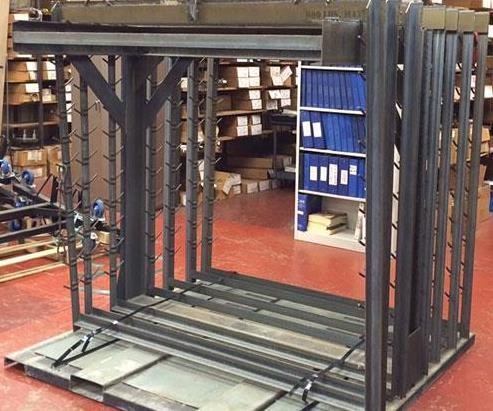Racking Up Profits in Coating Operations
Racking is often the first process when parts arrive at a finishing shop, but it’s the last process anyone thinks about when it comes to improving efficiencies and reducing costs.

Racking is often the first process when parts arrive at a finishing shop, but it’s the last process anyone thinks about when it comes to improving efficiencies and reducing costs.
Dan Davitz is hoping to change that perception.
The president of Production Plus Corp./Magic Rack, a company specializing in the design and manufacture of industrial racks, hooks and accessories in Columbus, Ohio, wants finishing shops to realize that the process begins with properly racking parts, which could lead to the biggest cost-savings for the entire operation.
“We’ve had customers who we’ve worked with on their entire system realize 200 to 400 percent increases in production just by tweaking the way they rack parts,” says Davitz. “Those numbers are real. When we tell people, they are staggered by it sometimes.”
It is not unusual for Magic Rack/Production Plus Corp. to help customers who have spent over $1 million on a new coating line only to see that
they should have worked all the kinks out of the new system much earlier.
Design Early
The key, Davitz says, is getting involved in the project as early as possible to design a racking system that fits the new line and avoid glitches and headaches.
“We work with a lot of installers who call us in at the right time to help them plan out how the racking will take place,” he says. “If coaters want the most optimal line speed and performance, then it is imperative to have the racking designed properly to fit the other components of the line.”
For example, a rack that holds six parts could be redesigned with the new system—taking into account line speed and part size—to hold up to 30 parts, which is a 400 percent increase in throughput and bottom-line profits.
That was the case for Technicoat Corp. in Durham, North Carolina. Owners Phil and Larry McLaurin knew they needed to increase the line density of their powder coating operation, so they called in Magic Rack to help them get the most for their money out of the line and help them win more bids.
“During the very first few months of business, we knew that pricing would have to be competitive and that line density was critical to meeting this challenge,” Larry McLaurin says. “There was going to be a need for a versatile racking method to efficiently hang parts to be coated. We needed to hang parts to maximize line density, minimize powder usage and promote a high quality finish.”

Racks can be loaded and unloaded offline, enabling the line speed to increase to its maximum while moving fully loaded racks to and from the line.
Love of Craft
That is what happened after Magic Rack installed a 4-tier and 1-tier system, as well as new snap-in hooks, on Technicoat’s then 1,500-foot coating line. Since then, the McLaurins have come back to Davitz and his team again when upgrading lines.
“Some of their designs are truly amazing,” Phil says. “I believe they have a real talent and love for their craft.”
Davitz says it is a love for the engineering, as well as a pursuit of helping customers get the most out of their expensive coating lines.
The process for racking improvements starts with Magic Rack doing a thorough inspection of the current or proposed system that the coater has or will soon install, then closely examining the parts to design a racking configuration that will handle both the coating line and the parts to maximize the finishing process.
“It’s important to discuss how much part control is needed, and what type of rack adjustability can be used to re-establish electrical ground if required,” Davitz says. “Then we look at what type of conveyor system it is, whether a power and free, a monorail, hoist or batch, and also whether they are able to paint from both sides or must the rack swivel.”
It’s also important to note any inclines or declines in the system, as well as the maximum degree. That detail will affect the center of gravity on the rack if the part is hung from two points, and the degree information is used to calculate the maximum rack width.
System Questions
Other important questions that need answers about the system:
- What is the conveyor pendant style? H attachment or swivel casting? Is it centered on 6, 8 or 24 inches? What is the maximum weight per pendant and the load bars?
- Will the racks be burned off for cleaning or exposed to
- an acid? Stainless hooks may be required versus high carbon steel.
- What are the smallest dimensions of the booth, oven, washer or tanks?
- How fast does the line travel? Can racks or heavy parts be loaded at that speed?
- How will racks be moved to and from the line area? How will they be loaded onto the conveyor and removed, since the rack must be easy-on and easy-off?
After that information is gathered, Davitz says the attention is turned to the part, and that is where even more critical information is gathered:
- Painting on both sides of the part or just one side? Swiveled?
- Powder coating, liquid coating or electrocoating?
- Any masking required?
- Will the part be washed? Will it drain naturally?
- Are there holes for hanging this part?
- Is the part light enough that it may blow off of a standard hook in the washer?
- What is the most important coverage area?
- Will a custom hook be needed for this part?
- Will a dedicated rack be needed for this part, or an adjustable rack with interchangeable crossbars?
- Will the hooks need changed out of the rack to accommodate other parts, and can we change the hooks at any time?
- Must the part be stabilized on the rack versus just hanging freely?
- Any blemishes allowed?
- What is the desired hanging position: side or front?
- Can this part be hung on both sides of a single crossbar?
- What is the max weight of the part?
- Are load bars required to carry the parts around the line relieving conveyor stress, or to distribute weight across pendants?
“It’s an exhausting list of things to look at closely, and often coaters just don’t take the time to ask those questions before designing or even installing a new system,” Davitz says.

Magic Rack has begun working with the finishing shops’ customers to see if racks can be staged and loaded at the workstation to eliminate re-handling of parts.
Eliminate Re-Handling
But over the past several years, Magic Rack dove deeper into the supply chain process to look further upstream to eliminate re-handling parts at the coating operation. That means examining whether or not the coating shops’ customers can rack parts at the operation when preparing the parts to be finished, eliminating time and additional costs of racking at the operation.
Davitz says that racks can be loaded and unloaded while “offline,” enabling the line speed to increase to its maximum while moving fully loaded racks to and from the line. “Most lines run slower than designed because they are hindered by the ‘people speed’ of hanging parts directly on the line,” he says.
Magic Rack works with the finishing shop’s customers to see if racks can be staged and loaded at the workstation to eliminate re-handling of parts. The company’s newly designed carts can be used to transport racks to and from the line after off-line loading and unloading.
In an effort to eliminate all manual handling of racks, the company’s engineering team advises its customers to consider the design of the racks, how they will be stored on carts to move to and from the line, loading and unloading off-line, transporting by truck and going into a burn-off oven or chemical strip tank for cleaning.
“All of those items must be considered, but it is an incredible time saver and money saver,” Davitz says. “The less a coater has to handle and rack parts, the lower he can bid the project and win the job.”
Keys to Successful Racking
Production Plus Corp./Magic Rack’s Dan Davitz says the return on investment for racks is often immediate due to the four cost saving areas:
- Increased line density (adding more parts per foot).
- Labor savings by eliminating daisy-chaining.
- Off-line loading/unloading to increase line speed and gain more parts per hour.
- Decreased overhead cost per part, resulting in increased profit per part.
Here are some tips that Davitz recommends when designing a racking system:
- Adjustability. Crossbars and hooks should be adjustable, instead of welded, racks. Valuable space is often wasted when racks are not set up for specific parts, and adjustable racks solve this problem.
- Time on target. Aim for “time on target” with rack designs. Flat racks often work best versus cylindrical rotating racks, particularly if automatic spray guns are moving.
- Inclines/declines. Consider inclines and declines in rack design. Typical conveyor lines have 30-degree inclines and declines that may enable racks to shift their center of gravity depending on the rack width and length dimensions. This is easily resolved with the right design.
- Rack width. Calculate the maximum rack width for line density. Calculate the maximum rack width taking into consideration the greatest degree of incline/decline on the conveyor if applicable. This is easy to calculate with an engineer or rack consultant.
- Hook designs. There will always be hard-to-hold parts with no holes, or straight rods with no holes. In cases like these, do not underestimate the value of a good custom designed hook. The part hook can make or break a job.
For information on Production Plus Corp./Magic Rack, please call 614-492-8811, or visit magicrack.com.
Related Content
Powder Coating Overcomes Post Forming
Six Sigma methodology, open communication, and collaboration produce results for leading boat manufacturer.
Read MoreOven Door Technology Improves Energy Efficiency
The RollSeal Door brings a compact, energy efficient and safe design to batch and conveyor style thermal processing units.
Read MoreIHEA Announces 2023-2024 Board of Directors
The Industrial Heating Equipment Association has announced its Board of Directors and Executive Officers for the coming year.
Read MoreHeat Up Your Maintenance Plan for Best Oven Performance
Improve efficiency and profitability with a preventive maintenance program for your industrial heating equipment.
Read MoreRead Next
Delivering Increased Benefits to Greenhouse Films
Baystar's Borstar technology is helping customers deliver better, more reliable production methods to greenhouse agriculture.
Read MoreA ‘Clean’ Agenda Offers Unique Presentations in Chicago
The 2024 Parts Cleaning Conference, co-located with the International Manufacturing Technology Show, includes presentations by several speakers who are new to the conference and topics that have not been covered in past editions of this event.
Read MoreEpisode 45: An Interview with Chandler Mancuso, MacDermid Envio Solutions
Chandler Mancuso, technical director with MacDermid Envio discusses updating your wastewater treatment system and implementing materials recycling solutions to increase efficiencies, control costs and reduce environmental impact.
Read More





















